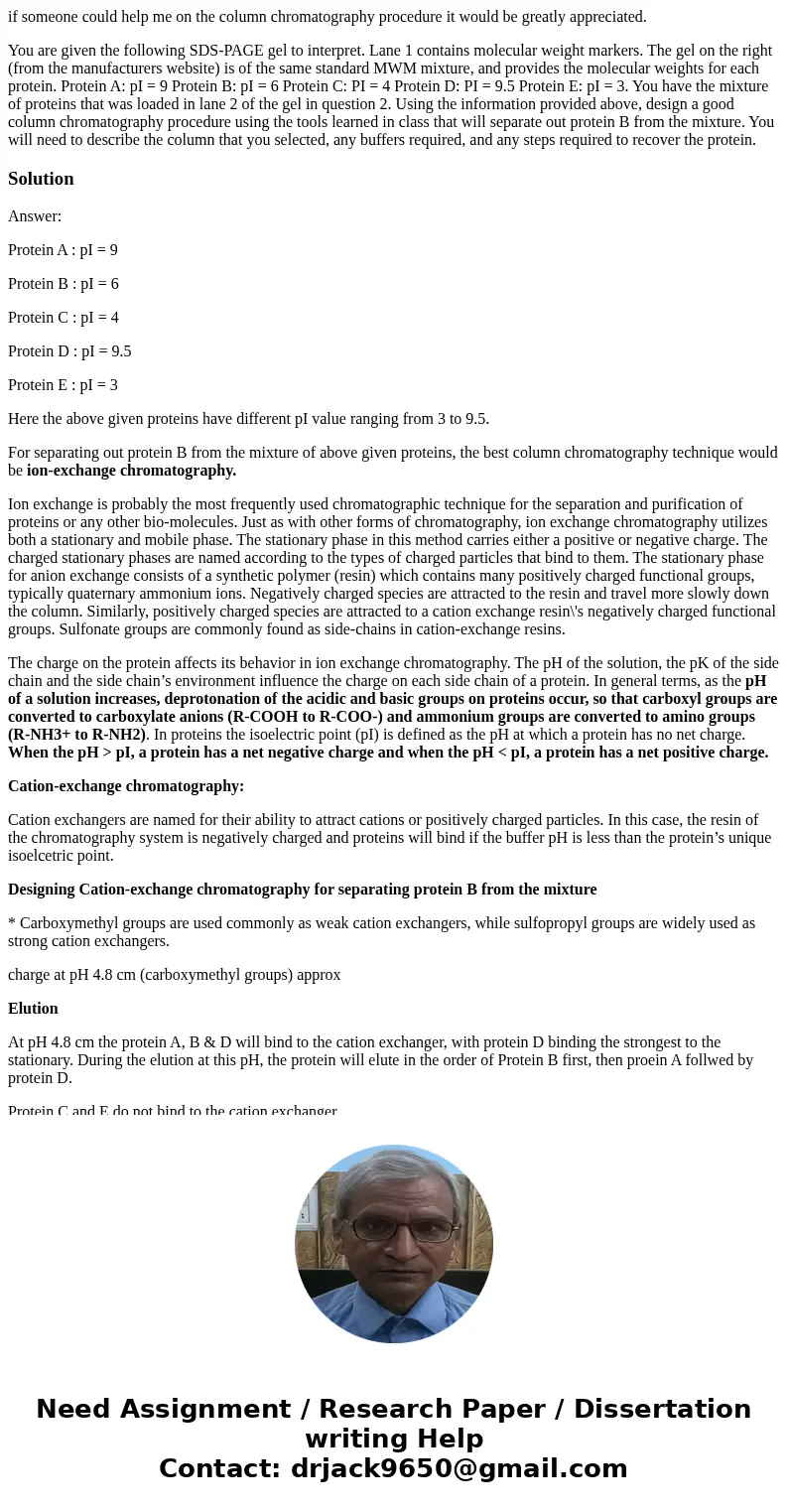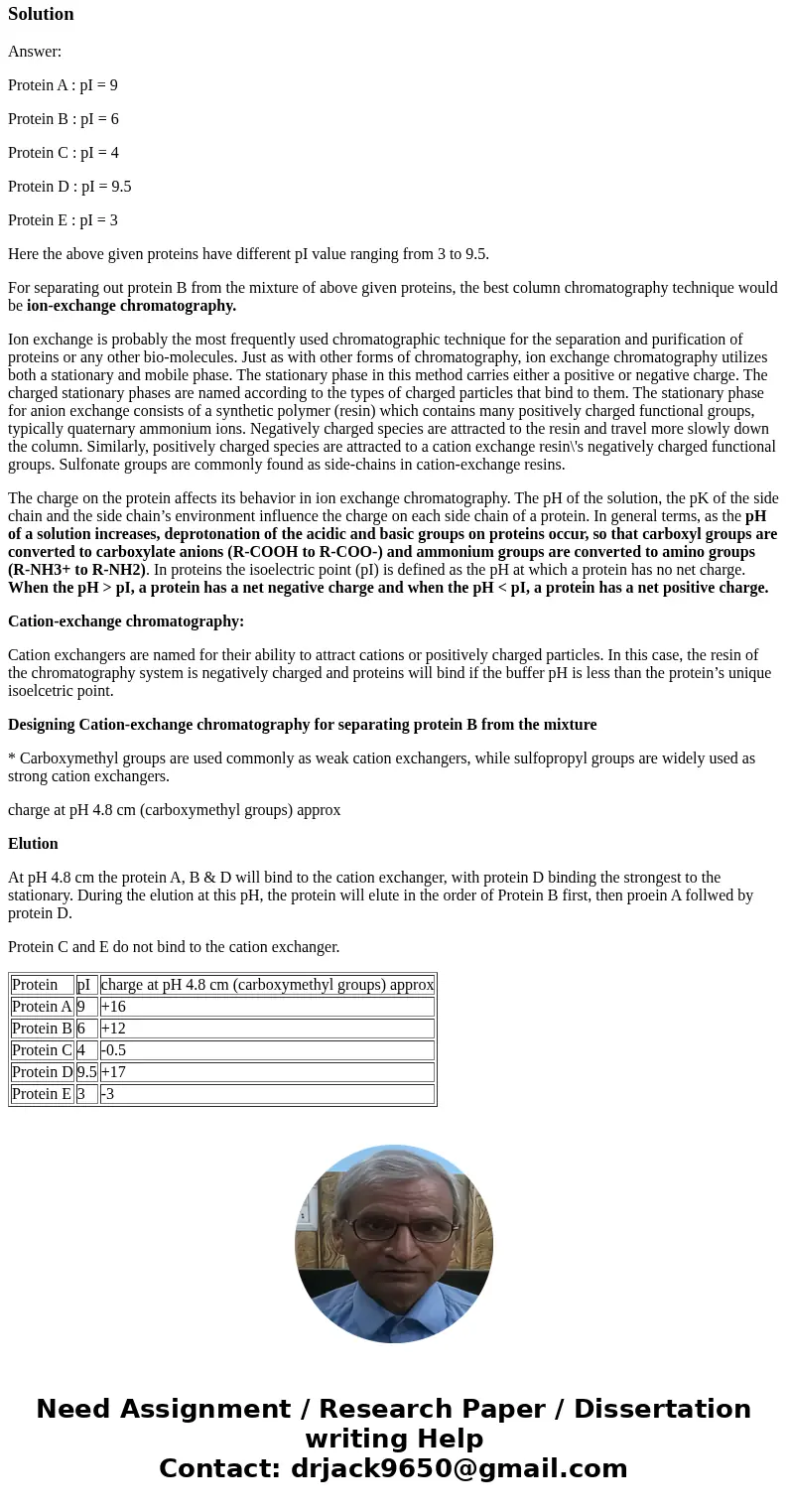if someone could help me on the column chromatography proced
if someone could help me on the column chromatography procedure it would be greatly appreciated.
You are given the following SDS-PAGE gel to interpret. Lane 1 contains molecular weight markers. The gel on the right (from the manufacturers website) is of the same standard MWM mixture, and provides the molecular weights for each protein. Protein A: pI = 9 Protein B: pI = 6 Protein C: PI = 4 Protein D: PI = 9.5 Protein E: pI = 3. You have the mixture of proteins that was loaded in lane 2 of the gel in question 2. Using the information provided above, design a good column chromatography procedure using the tools learned in class that will separate out protein B from the mixture. You will need to describe the column that you selected, any buffers required, and any steps required to recover the protein.Solution
Answer:
Protein A : pI = 9
Protein B : pI = 6
Protein C : pI = 4
Protein D : pI = 9.5
Protein E : pI = 3
Here the above given proteins have different pI value ranging from 3 to 9.5.
For separating out protein B from the mixture of above given proteins, the best column chromatography technique would be ion-exchange chromatography.
Ion exchange is probably the most frequently used chromatographic technique for the separation and purification of proteins or any other bio-molecules. Just as with other forms of chromatography, ion exchange chromatography utilizes both a stationary and mobile phase. The stationary phase in this method carries either a positive or negative charge. The charged stationary phases are named according to the types of charged particles that bind to them. The stationary phase for anion exchange consists of a synthetic polymer (resin) which contains many positively charged functional groups, typically quaternary ammonium ions. Negatively charged species are attracted to the resin and travel more slowly down the column. Similarly, positively charged species are attracted to a cation exchange resin\'s negatively charged functional groups. Sulfonate groups are commonly found as side-chains in cation-exchange resins.
The charge on the protein affects its behavior in ion exchange chromatography. The pH of the solution, the pK of the side chain and the side chain’s environment influence the charge on each side chain of a protein. In general terms, as the pH of a solution increases, deprotonation of the acidic and basic groups on proteins occur, so that carboxyl groups are converted to carboxylate anions (R-COOH to R-COO-) and ammonium groups are converted to amino groups (R-NH3+ to R-NH2). In proteins the isoelectric point (pI) is defined as the pH at which a protein has no net charge. When the pH > pI, a protein has a net negative charge and when the pH < pI, a protein has a net positive charge.
Cation-exchange chromatography:
Cation exchangers are named for their ability to attract cations or positively charged particles. In this case, the resin of the chromatography system is negatively charged and proteins will bind if the buffer pH is less than the protein’s unique isoelcetric point.
Designing Cation-exchange chromatography for separating protein B from the mixture
* Carboxymethyl groups are used commonly as weak cation exchangers, while sulfopropyl groups are widely used as strong cation exchangers.
charge at pH 4.8 cm (carboxymethyl groups) approx
Elution
At pH 4.8 cm the protein A, B & D will bind to the cation exchanger, with protein D binding the strongest to the stationary. During the elution at this pH, the protein will elute in the order of Protein B first, then proein A follwed by protein D.
Protein C and E do not bind to the cation exchanger.
| Protein | pI | charge at pH 4.8 cm (carboxymethyl groups) approx |
| Protein A | 9 | +16 |
| Protein B | 6 | +12 |
| Protein C | 4 | -0.5 |
| Protein D | 9.5 | +17 |
| Protein E | 3 | -3 |


 Homework Sourse
Homework Sourse